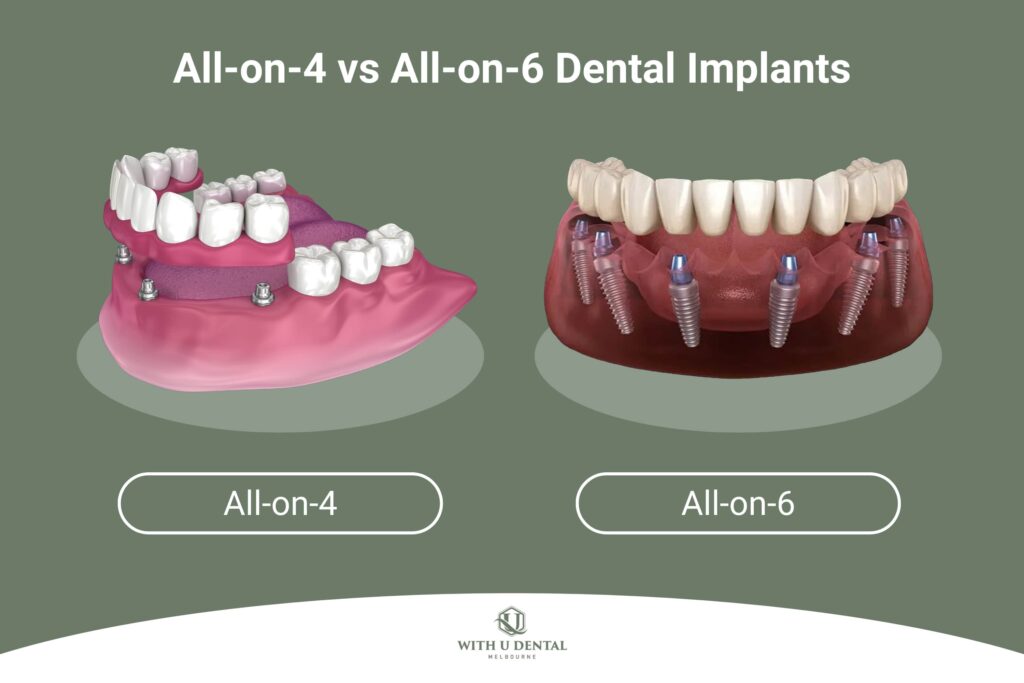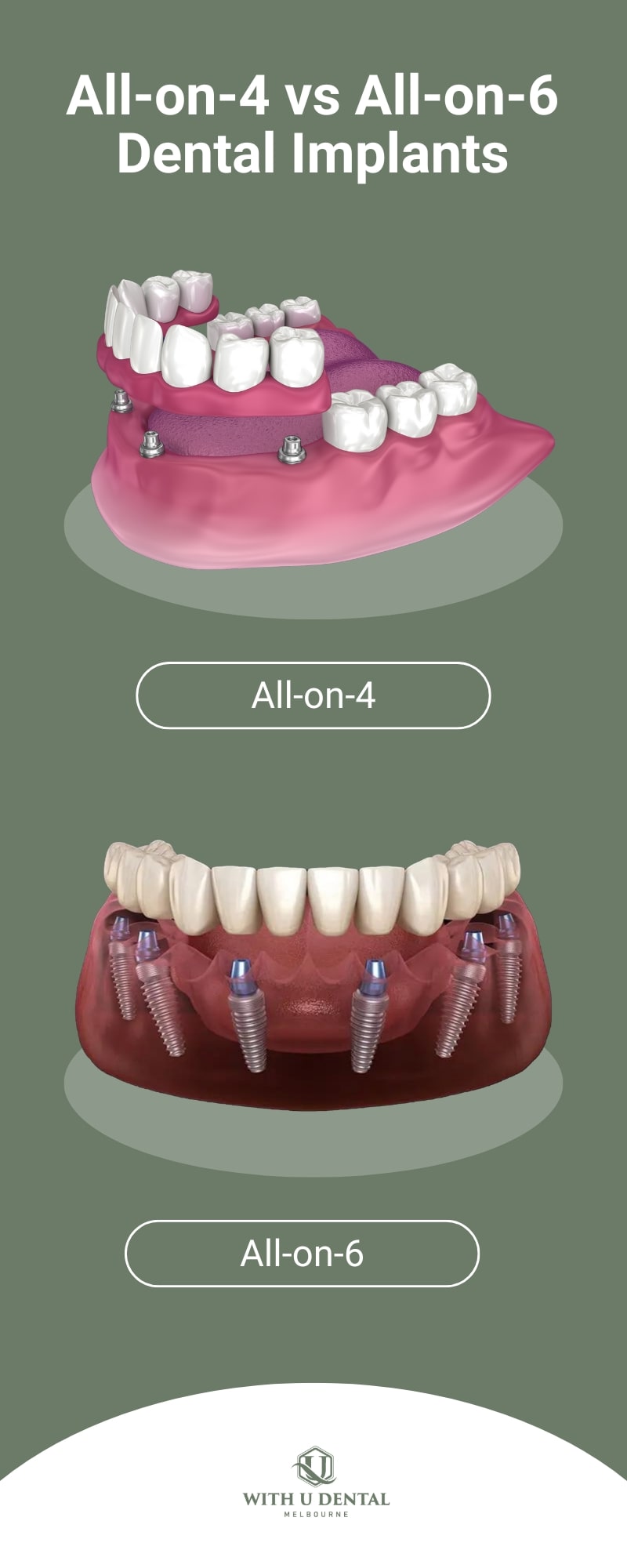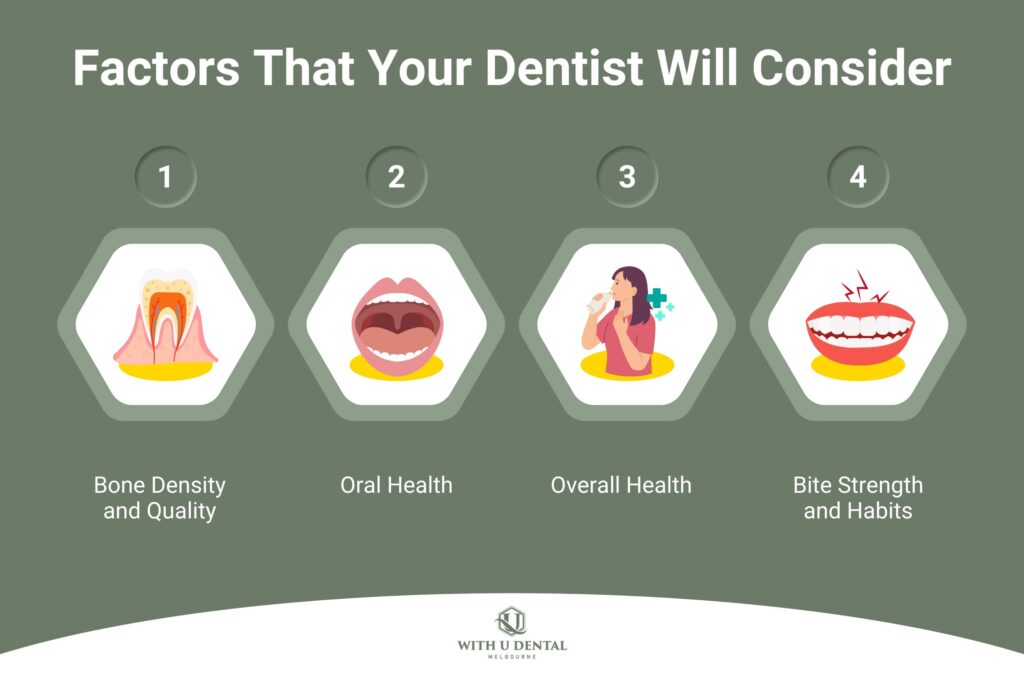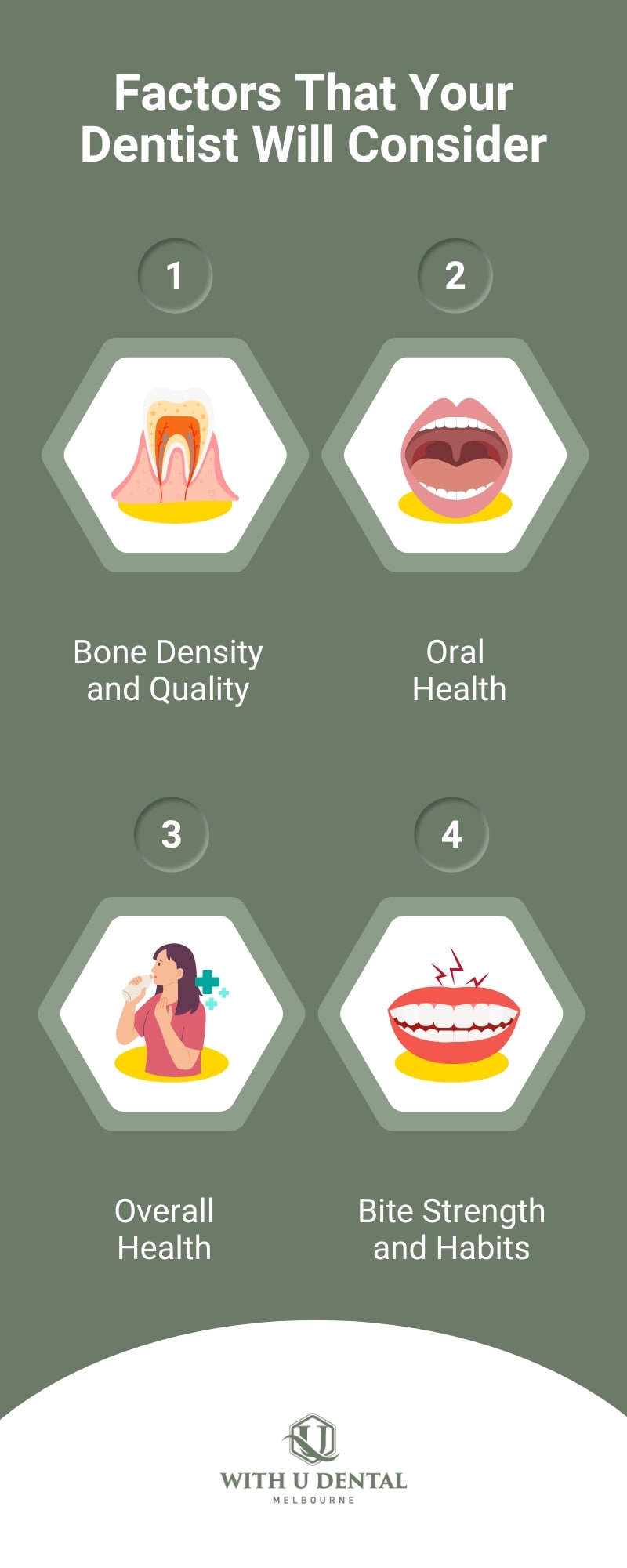All-on-4 implants are recommended for those with limited bone density, offering a quicker recovery and fewer implants. All-on-6 implants provide extra support and durability for those who need a more robust solution. However, they might involve a more complex procedure and higher costs.
Choosing between All-on-4 vs All-on-6 dental implants depends on your specific dental health and the level of stability you need. Let’s do a deeper comparison of All-on-4 vs All-on-6 so you can pick the right one for your needs.
What Are All-on-4 vs All-on-6 Dental Implants?


All-on-4 and All-on-6 dental implants are advanced dental procedures. They replace a full arch of lost teeth in your upper or lower jaw using strategically placed implants. These implants act as anchors for a fixed denture, restoring your smile and ability to eat normally. The main difference lies in the number of implants used:
All-on-4
The All-on-4 dental implant procedure relies on four carefully positioned dental implants. These support a full set of replacement teeth. It’s a good option for people with very little bone loss who still have enough bone density for the implants.
All-on-6
This procedure uses six carefully placed dental implants for increased stability of your new teeth. It’s an excellent choice if you need extra support or want the most complete set of replacement teeth possible (e.g., if they have a wide smile).
Similarities of All-on-4 vs All-on-6
- Purpose: Both techniques provide full-arch restoration. They are ideal solutions for patients who have lost most or all of their teeth in one or both jaws.
- Permanent Solution: They are permanent implant solutions that anchor prosthetic teeth directly to the jawbone. There’s no need for traditional removable dentures.
- Immediate Load: Both systems often allow for immediate load implants. This means the prosthetic teeth can be placed soon after the implants are placed, reducing overall treatment time.
- Fewer Implants: Traditional methods need one implant per tooth. Both All-on-4 and All-on-6 reduce the number of implants and surgeries required.
- Improved Oral Health and Function: Each method significantly improves oral functionality. They allow for easier chewing and clearer speaking, and they help preserve the jawbone and facial structure.
- Aesthetic Outcomes: Both offer improvements in aesthetics. Patients will enjoy a natural-looking set of teeth and improve overall facial appearance.
Key Differences Between All-on-4 and All-on-6
- Number of Implants: All-on-4 uses four implants, while All-on-6 implants use six. The additional two implants used in All-on-6 implants provide extra support and stability for the dental bridge, especially in the back of the jaw.
- Bone Grafting: 5 to 7% of All-on-6 patients need bone grafting compared to just 5% of All-on-4 patients. In general, the All-on-4 procedure requires less bone for successful implants.
- Stability and Strength: All-on-6 offers increased stability and strength. The two additional implants help distribute chewing forces more evenly across the jaw.
- Cost: All-on-6 generally costs more than All-on-4. This is due to the extra implants and the potential need for additional procedures.
- Maintenance: Cleaning All-on-6 dental implants can be more challenging due to the presence of more implants and the configuration of the dental bridge.
- Implant Orientation: The All-on-4 technique often uses angled implants to make the most of existing bone. All-on-6 uses vertical implants that require more healthy jawbone for support.
Types of Replacement Teeth for All-on-4 vs All-on-6 Dental Implants
The types of replacement teeth are the same for All-on-4 and All-on-6 procedures. These include:
Hybrid Denture
Hybrid bridge dental prostheses replace an entire arch of missing teeth (upper, lower, or both). Instead of needing a single implant for every tooth, a full bridge of new teeth is supported by a few strategically placed dental implants (usually 4 to 6).
This can streamline the procedure. It can allow for immediate installation after tooth removal and implant placement.
A hybrid bridge prosthesis consists of three main components:
- Titanium implants placed into the jawbone
- Abutments that connect the implants to the bridge
- The prosthetic bridge itself that replaces the missing teeth.
The hybrid denture is permanently fixed and feels stable and natural when eating and speaking. It also helps support facial structure and can be easier to clean than some removable denture options.
Implant-Supported Bridge
Implant-supported bridges are a permanent tooth replacement solution for multiple missing teeth. They have dental implants, surgically placed into the jawbone, as anchors for a custom-designed bridge.
This provides a stable, natural-looking restoration that doesn’t slip, like dentures. Implant-supported bridges help preserve jawbone health, improve chewing and speaking, and offer a long-lasting, confident smile.
What Is the Recovery Time for All-on-4 vs All-on-6 Dental Implants?
All-on-4
- Initial Recovery: Most patients experience mild to moderate discomfort, swelling, and bruising for a few days after the procedure. This can usually be managed with over-the-counter pain medication and ice packs.
- Soft Diet: You’ll need to follow a liquid and soft food diet for several days to allow for initial healing.
- Return to Work: Most people can return to work and normal activities within 2 to 3 days.
- Temporary Denture: You’ll have a temporary denture placed immediately after implant surgery. This allows you to eat and speak normally during the healing phase.
- Final Restoration: After 3 to 6 months, the implants will fully integrate with your jawbone. At this time, your permanent denture will be fitted.
All-on-6
- Similar to All-on-4: The initial recovery for All-on-6 dental implant surgery is very similar to All-on-4. Expect mild discomfort, temporary dietary restrictions, and a quick return to normal activities.
- Potential for Longer Healing: All-on-6 involves more implants. Some patients with these dental implants may need slightly longer healing times or more extensive surgery.
All-on-6 vs All-on-4: Who Is an Ideal Candidate?
All-on-6 Dental Implants
The All-on-6 procedure involves placing six dental implants or screws. This offers better stability and distribution of force across a larger area of the jaw. Ideal candidates for All-on-6 include those who:
- Have lost all or most of their teeth but have high bone density, capable of supporting more implants
- Require a stronger foundation for their prosthetic teeth due to jaw size or bite force
- Can undergo a slightly longer procedure and a more extended recovery period
- Need to have more replacement teeth installed (7 per quadrant or 14 per arch).
All-on-4 Dental Implants
All-on-4 dental implants involve placing four implants in the jaw. This procedure is recommended for patients who:
- Have a high level of tooth loss or decay
- Lack the bone density needed for more extensive implant procedures but still have enough to support four dental implants
- Prefer a cost-effective solution compared to other methods that need more implants.
Factors That Your Dentist Will Consider


1. Bone Density and Quality
- Evaluation: Your dentist will use X-rays, CBCT scans, or 3D imaging to thoroughly assess the health, density, and volume of your jawbone.
- All-on-4 Advantage: The unique angle of the rear implants in All-on-4 allows it to work with less bone density in certain cases.
- All-on-6 Preference: All-on-6 requires more bone density for the successful integration of the six implants. If your bone quality is very compromised, bone grafting procedures may be necessary.
2. Oral Health
- Gum Disease: Any active periodontal (gum) disease must be fully treated before implant surgery. Severe gum disease can compromise the success of the implants.
- Number of Missing Teeth: All-on-4 and All-on-6 replace an entire upper or lower arch of teeth, so significant tooth loss is required.
3. Overall Health
- Medical Conditions: Conditions like uncontrolled diabetes, osteoporosis, immune disorders, or radiation therapy to the jaw area can complicate the healing process and implant success. Your dentist will need a full understanding of your medical history.
- Smoking: Smoking significantly increases the risk of implant failure. It needs to be addressed before considering implants.
4. Bite Strength and Habits
- Powerful Bite: If you have a very strong bite, All-on-6’s additional implants may provide better long-term stability and reduce stress on individual implants.
- Grinding/Clenching: These habits (bruxism) put excessive pressure on restorations. This can influence implant choice or the need for protective night guards.
What to Expect During the Treatment Process
Both the All-on-6 and All-on-4 procedures follow a similar treatment process. It usually involves these steps:
Initial Consultation and Planning
- Evaluation: Your dentist will examine your teeth, gums, and jawbone to see if you’re a good candidate for implants. This includes X-rays and possibly 3D scans.
- Treatment Plan: You’ll discuss your goals, material preferences, and budget. Your dentist will design a customised treatment plan tailored to your needs.
- Pre-Procedure Prep: If necessary, this may involve treating gum disease or extracting teeth to prepare your jaw for implants.
Day of Surgery
- Anaesthesia: The procedure is typically performed under local anaesthetic with sedation. Sometimes general anaesthetic is used, depending on your needs.
- Tooth Removal: Any remaining teeth in the affected arch are removed.
- Implant Placement: Four dental implants or six dental implants are surgically placed into your jawbone.
- Temporary Denture: A temporary denture is immediately attached to the implants. You leave the office with a functional set of teeth.
All-on-4 vs All-on-6 Dental Implants Cost
All-on-6 is more expensive than the All-on-4 because of the two extra implants.
| All-on-6 Cost | All-on-4 Cost |
| $25,000 – $30,000 range for a single arch | $20,000 – $25,000 for a single arch |
The total cost will depend on factors like the extent of pre-treatment work (e.g., extractions, bone grafts), the type of anaesthesia needed (local or general), and the quality and implant material used for your replacement teeth.
At With U Dental, we understand the investment involved in All-on-4 or All-on-6 implants. This is why we offer flexible payment plans designed to fit your budget. Discuss your financing options with your dentist or reach out to our team for more details.
Conclusion
All-on-4 and All-on-6 offer a permanent solution for replacing a full arch of lost teeth. All-on-4 usually requires less bone density, while All-on-6 offers increased stability. Both improve chewing ability, speech, and aesthetics.
Could All-on-4 or All-on-6 dental implants be the solution to your missing teeth? Find out! Contact With U Dental for a complimentary implant consultation today!
All-on-4 vs All-on-6 Implants FAQs
All-on-4 or All-on-6 Implants – Which Is Best?
The choice between All-on-4 and All-on-6 ultimately rests with your dentist. All-on-6 may offer greater stability. However, your dentist will assess factors like bone density and bite strength to determine the best solution for your specific needs.
Is Getting All-on-4 or All-on-6 Painful?
The All-on-4 and All-on-6 procedures are not painful thanks to anaesthesia. You can expect mild to moderate discomfort and swelling for a few days after your surgery. It’s easily managed with medication and following your dentist’s instructions.
How Long Do All-on-6 Implants Last?
All-on-6 dental implants can last for 20 years with proper dental care and good oral hygiene. However, due to normal wear and tear, the prosthetic teeth (crowns) attached to the straight implants might need replacing after 10 to 15 years.
Can All-on-4 Implants Be Done in One Day?
Yes, one of the major advantages of the All-on-4 procedure is that it can often be completed in a single day. You’ll receive immediate-load implants and a temporary denture will be attached on the same day as your implant surgery.
Do All-on-4 or All-on-6 Implants Look Natural?
Yes, both All-on-4 and All-on-6 can look incredibly natural. Thanks to advanced dental technology and skilled dentists, custom-made dentures closely resemble your natural teeth in colour, shape, and overall look.
Note: Any surgical or invasive procedure carries risks. Before proceeding, you should get a second opinion from an appropriately qualified health practitioner.
Back to top: All-on-4 vs All-on-6 Dental Implants


